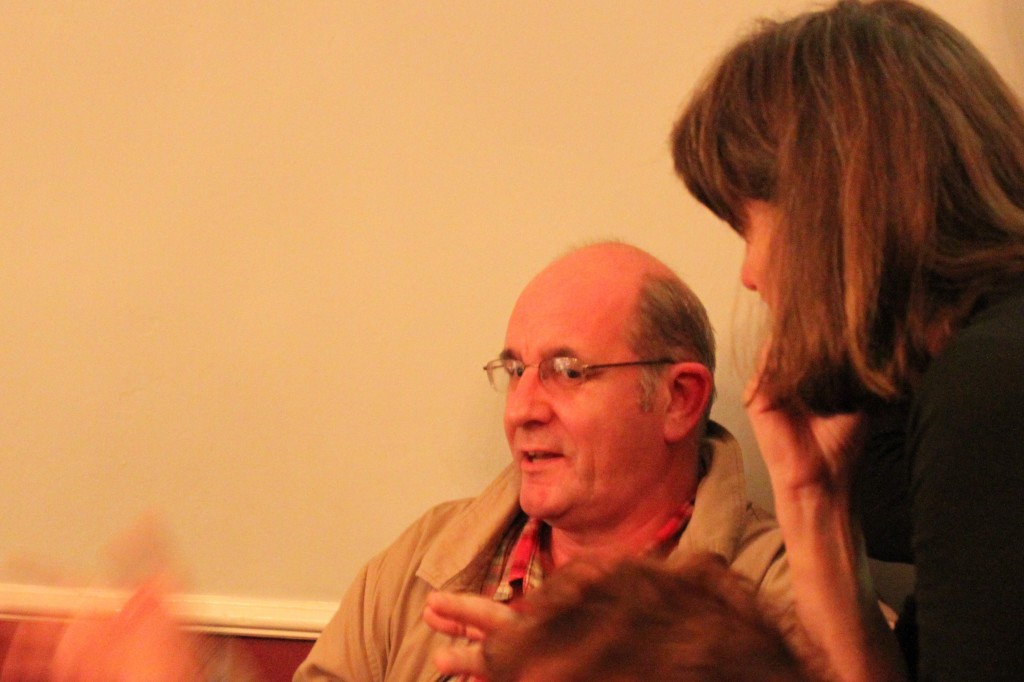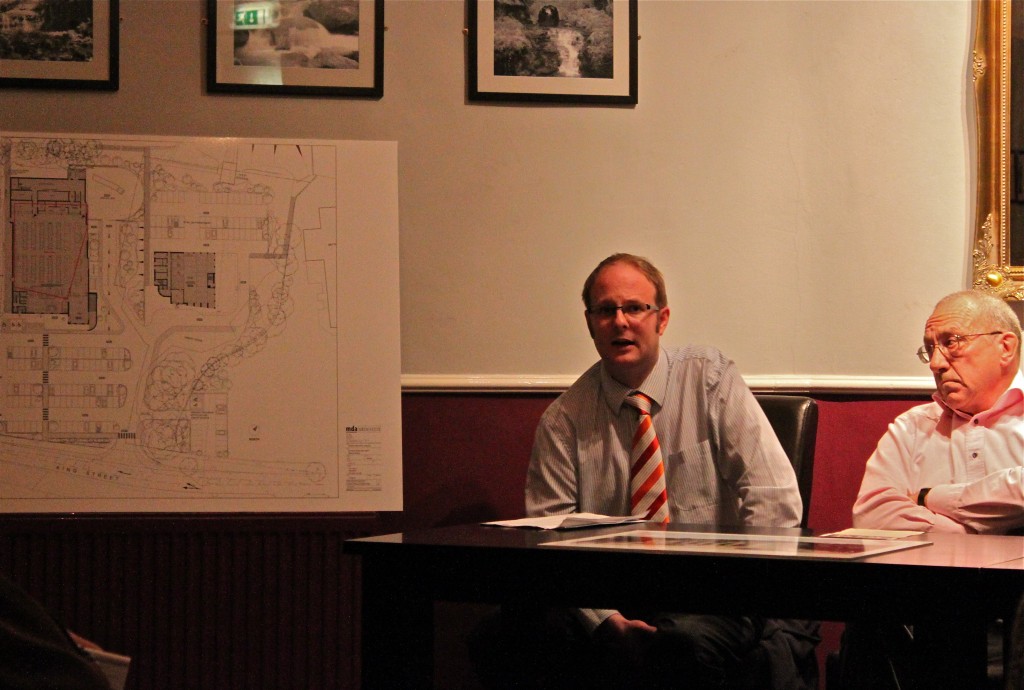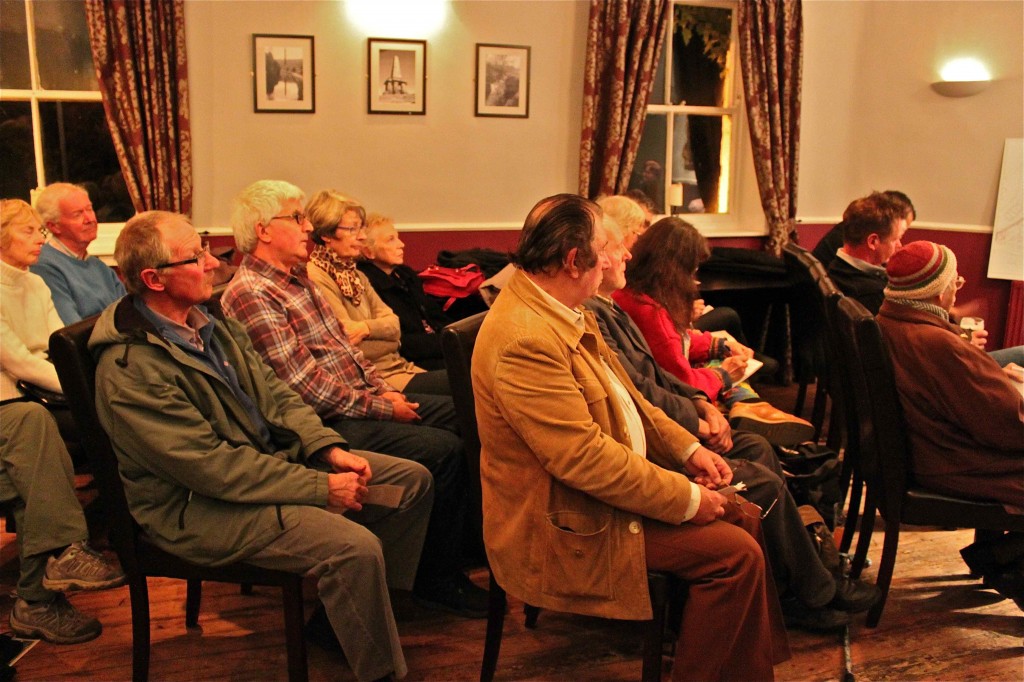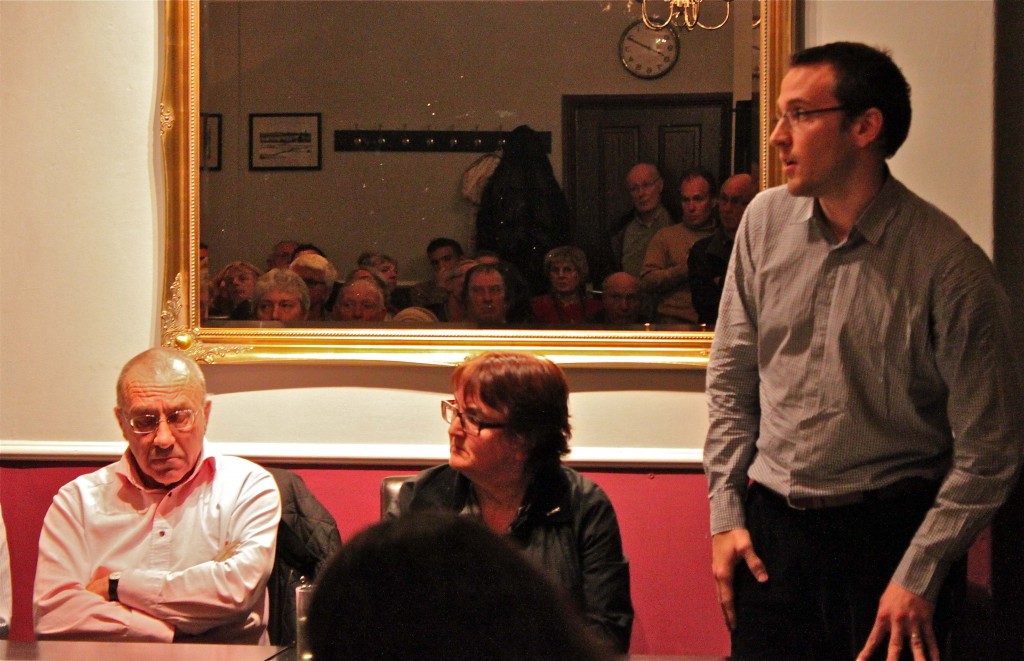Chaired by Calderdale Councillor Janet Battye, a packed public meeting upstairs at the Stubbing Wharf pub fired questions about the proposed supermarket and hotel development to Calderdale planning officer Richard Seaman, architect Sam Deakin and the developers’ planning consultant Roger Lee.

Speaker after speaker questioned the desirability and feasibility of the proposed supermarket and hotel development. Those speaking in favour were in a minority.
People’s questions clustered around:
- jobs and economics of the supermarket and hotel
- traffic impacts
- flooding
- alternative ideas for developing Mytholm Works site
- how democratic the planning process is and how/whether people can have an effective say in it
- building style/aesthetics
According to Dr Lindsay Smales, Leeds Metropolitan University urban planning lecturer, the problem is that the meeting was about “reactive planning to proposals that developers have already come up with.” Hebden Bridge doesn’t have a coherent neighbourhood plan and this is because Hebden Royd Town Council has failed to provide funding to Hebden Bridge Town Partnership to create such a plan. “But that is the way forward.”
Emma Green, Hebden Royd Town Council Neighbourhood Manager, has asked Energy Royd to clarify that Hebden Royd Town Partnership has been considering the preparation of a neighbourhood plan, but it hasn’t asked Hebden Royd Town Council to fund this work.
How people can democratically affect the planning decision
Richard Seaman focussed people’s minds when he explained that although members of the public can comment on the planning application (for or against) until 8th November, Calderdale Council planning officers will make their assessment
“against planning policy. People can have a say in the process, but there’s no threshold of objections that will cause the planners to stop the application.”
This prompted a slew of questions (as well as some outraged remarks), which drew out the following information:
Planners will only take account of comments from members of the public if they are about “material considerations” – in other words, comments that refer specifically to the planning policy issues that affect the site.
For the Mytholm works site, material considerations are:
BE2 Privacy, daylight and amenity
BE5 Design & layout of highways
NE15 Development within wildlife corridors (the site is a designated wildlife corridor)
NE16 Protection of protected species
NE21 Trees & development sites
EP17 Protection of indicative floodplain
EP27 Renewable energy development
The site is also a protected employment site.
A handout from Chris Standish clarifies that, to comment on “material considerations” people should write about:
1. whether the type of use (hotel/supermarket) is acceptable (see Jobs & economics section,below)
2. materials, layout and design
3. residential amenity – ie how it affects people living nearby
4. impact on businesses
5. highways
6. environmental/green issues/wildlife
7. flooding
8. open space
9. trees and landscaping
10. financial viability
The Localism Act, Calderdale Incredible Edible and Community Growing Policy, and putting the Mytholm Works site on the Community Asset Register
Chris Standish’s hand out refers to the Localism Act and how that affects planning.
The idea of an alternative community-owned development based on a super market garden (that combines intensive permaculture and aquaculture growing with a farm gate retail outlet for local food produce, an educational centre, eco hotel and green tourist attraction) is in line with Calderdale Council’s policy, Incredible Edible Calderdale, that draws on the Localism Act.
Calderdale’s Incredible Edible and Community Growing policy agrees that:
- the Council should continue to support community growing projects wherever possible and feasible
- community growing opportunities should be reflected in the development of an Asset Register for Calderdale as required by the Localism Act 2011.
These are also the two main elements of the alternative community growing proposal, and surely they must count as “material considerations” in relation to bullet points 1,3,4,6,7,8,9 above.
In addition to these Calderdale Council policies, the National Planning Policy Framework specifies as a Core Principle that planning should be a “creative exercise in finding ways to enhance and improve places where people live…supporting the transition to a low-carbon future…”
In response to questions about alternative developments, Richard Seaman said,
“If people have aspirations for a different type of development, they have to talk to the developers.”
What happens after the deadline for comments from the public?
Richard Seaman said that either the planning department will make a delegated decision (ie one planning officer decides whether to approve it or not), or it will go to the planning committee to decide.
A contentious planning application like this is almost certain to go to the planning committee. Even if the planning department wanted to make it a delegated decision, the ward Councillor can call it to the planning committee. With this amount of popular interest and dispute, no ward Councillor is likely to let the planning department make a delegated decision.
However, the final decision is not with the elected Councillors. If the planning committee refused the application, the developers may well appeal. In that case, the Planning Inspector would decide.
Jobs and economics
The figure of 100 jobs at the proposed supermarket and hotel is based on the developers’ estimate of the number of jobs the supermarket and hotel would create. Roger Lee, the developers’ planning consultant, didn’t say what this estimate is based on.
For purposes of comparison, the Hebden Bridge Coop (a bit smaller than the proposed supermarket) currently employs 38 staff, some full time, some part time. And a Travelodge press release announcing the opening of a 56 bed hotel in Southend carried an advertisement for 24 new jobs: 1 Assistant Lodge Manager, 3 Reception staff, 5 Night duty staff, 15 Guest room cleaners. So a more realistic number of new jobs looks to be 70 ish (allowing for the fact that the proposed supermarket is a bit bigger than the Coop). And of these probably less than half would be full time. (Of the hotel jobs, only 4 look like full time jobs.)
In terms of Calderdale Council’s planning policy, the Mytholm Works site is an allocated employment site for offices, light industry, general industry and warehouses. Richard Seaman said “ This doesn’t entirely close the door to retail and hotel development- it’s up to the developer to show that this is adequate in terms of employment. The Council will have to consider this on its merits and reach a decision.”
What Richard Seaman didn’t say is that Policy E3 advises that
“proposals for employment uses not within these classes [ offices, light industry, general industry and warehouses ] will only be supported in exceptional circumstances.”
People asked how many of these proposed jobs were full time equivalents, and how many HB businesses would go out of business and become unemployed – including market traders and Farmers’ Market traders. Richard Seaman replied,
“ Issues of retail impact are part of the assessment. It’s an out of town centre retail site, so the onus is on the developer to show it won’t cause unacceptable harm to the vitality and viability of the town – whether ultimately it’ll result in shops closing down and the centre becoming a less attractive place.”
The developers’ planning consultant Roger Lee added,
“We’ve had to complete a figure for employment for the planning process. The figure is what would be expected based on figures for similar-sized supermarkets and hotels.”
Roger Lee’s planning statement defends the proposal for falling outside the types of employment allocated for this site by saying
“ the scale and use of the site will provide employment opportunities at least equal to those that could expect to be generated from” the types of employment allocated for this site.
So the accuracy of the job figures are clearly crucial to this planning application.
Traffic impacts
There were many questions and comments about the inadequacies of the developers’ traffic impact assessment .




